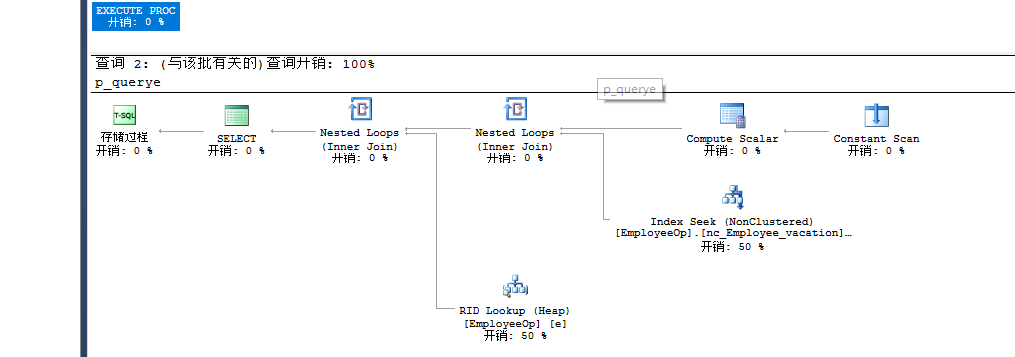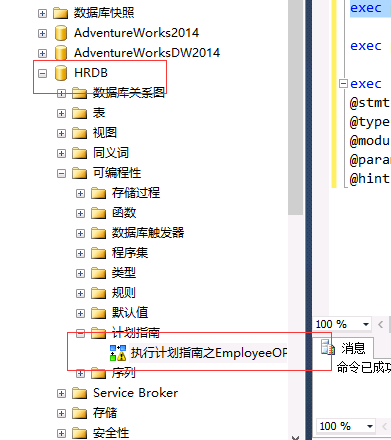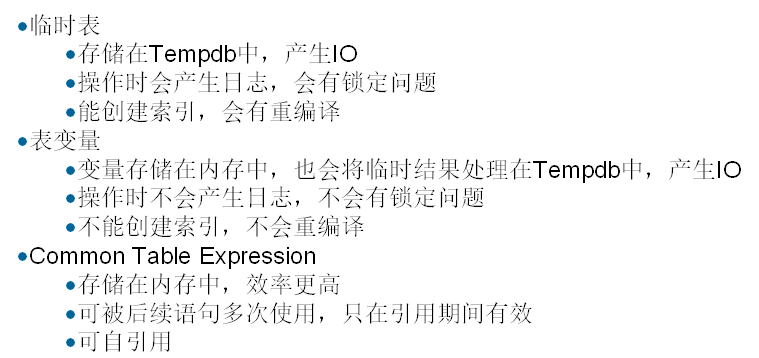SqlServer性能优化 即席查询(十三)
执行计划,查询类别:
1.即席查询 2.预定义查询
select c.EnglishProductCategoryName,p.EnglishProductName,p.Color,p.Size
from Product as p inner join ProductCategory as c on p.ProductSubcategoryKey=
c.ProductCategoryKey where p.Size>'1'
--查询执行计划是否被缓存
select c.usecounts,c.size_in_bytes,c.objtype,t.text from sys.dm_exec_cached_plans as c
cross apply sys.dm_exec_sql_text(c.plan_handle) as t dbcc freeproccache--清空执行计划
--没有join 的形式会生成简单参数化
select EnglishProductName,Color,Size from Product where size>'1'--简单参数化 select EnglishProductName,Color,Size from Product where size>'2'--简单参数化

select c.EnglishProductCategoryName,p.EnglishProductName,p.Color,p.Size
from Product as p inner join ProductCategory as c on p.aProductSubcategoryKey=
c.ProductCategoryKey where p.Size>'2'
语句一样时即席查询才会重用执行计划。

优化:打开开关
exec sp_configure 'show advanced options',1
reconfigure with override
为ad hoc的查询优化:
exec sp_configure 'Optimize for ad hoc workloads',1
reconfigure with override

--使用参数化
alter database HRDB
set Parameterization forced
set Parameterization forced 强制参数化(like无法识别 )
select c.EnglishProductCategoryName,p.EnglishProductName,p.Color,p.Size
from Product as p inner join ProductCategory as c on p.ProductSubcategoryKey=
c.ProductCategoryKey where p.Size>'2' select c.EnglishProductCategoryName,p.EnglishProductName,p.Color,p.Size
from Product as p inner join ProductCategory as c on p.ProductSubcategoryKey=
c.ProductCategoryKey where p.Size like '2%'
预定义查询:
预定义查询--参数化执行计划:
存储过程:
1.创建时延时检查
2.第一次执行时编译并生成执行计划
3.减少网络传输量
4.封装变化点
5.增强安全性,隔离访问控制
创建存储过程:
create procedure p_querycp @size varchar(500)
as
select c.EnglishProductCategoryName,p.EnglishProductName,p.Color,p.size
from Product as p inner join ProductCategory as c on p.ProductSubcategoryKey=c.ProductCategoryKey
where p.Size>@size
做跟踪(以前有对应得截图):
执行存储过程:
create procedure p_querycp @size varchar(500)
as
select c.EnglishProductCategoryName,p.EnglishProductName,p.Color,p.size
from Product as p inner join ProductCategory as c on p.ProductSubcategoryKey=c.ProductCategoryKey
where p.Size>@size --清空执行计划
dbcc freeproccache
--执行
exec p_querycp '1'
执行重复的语句:
dbcc freeproccache exec p_querycp @size='1' exec p_querycp @size='2'
查看缓存计划:
select c.usecounts,c.size_in_bytes,c.objtype,t.text from sys.dm_exec_cached_plans as c
cross apply sys.dm_exec_sql_text(c.plan_handle) as t

预定义查询---参数化执行计划:
SP_ExecuteSql
避免了自己维护存储过程管理成本
可重用执行计划
Unicode字符串作为参数值与类型
大小写敏感
把存储过程定义成传递参数的:
declare @sqltext nvarchar(500)
set @sqltext=N'
select c.EnglishProductCategoryName,p.EnglishProductName,p.Color,p.size
from Product as p inner join ProductCategory as c on p.ProductSubcategoryKey=c.ProductCategoryKey
where p.Size>@size
'
declare @params nvarchar(500)
set @params=N'@size varchar(500)'
exec sp_executesql @sqltext,@params,@size='1'

把size 的大小换成 2

在.net中调用:(两种写法)
public object getCp(string size)
{
HRUser dbcontext = new HRUser();
var cps = from p in dbcontext.Product
join c in dbcontext.ProductCategory
on p.ProductSubcategoryKey equals c.ProductCategoryKey
where p.Size == size
//返回匿名对象
select new
{
CName = c.EnglishProductCategoryName,
PName = p.EnglishProductName,
Color = p.Color,
Size = p.Size
};
return cps.ToList();
}
public object getcp(string size)
{
HRUser dbcontext = new HRUser();
var cps = dbcontext.Product.Join(dbcontext.ProductCategory, a => a.ProductSubcategoryKey, ar => ar.ProductCategoryKey, (a, ar) => new
{
CName = ar.EnglishProductCategoryName,
PName = a.EnglishProductName,
Color = a.Color,
Size = a.Size
}).Where(p => p.Size == size);
return cps.ToList();
}
页面:
<asp:TextBox ID="TextBox1" runat="server"></asp:TextBox>
<asp:Button ID="Button2" runat="server" OnClick="Button2_Click" Text="显示产品" />
<asp:GridView ID="GridView1" runat="server">
</asp:GridView>
点击后的事件:
protected void Button2_Click(object sender, EventArgs e)
{
Product p = new Product();
var cps = p.getCp(TextBox1.Text.Trim());
GridView1.DataSource = cps;
GridView1.DataBind();
}

--动态构建语句(执行带参数的方法)
declare @size varchar(500)
set @size='2'
execute('select c.EnglishProductCategoryName,p.EnglishProductName,p.Color,p.size
from Product as p inner join ProductCategory as c on p.ProductSubcategoryKey=c.ProductCategoryKey
where p.Size>'+''''+@size+'''')
dbcc freeproccache --执行计划 缓存
select c.usecounts,c.size_in_bytes,c.objtype,t.text from sys.dm_exec_cached_plans as c
cross apply sys.dm_exec_sql_text(c.plan_handle) as t
形成两个缓存计划:

创建存储过程:
create procedure p_querye @vacationhours int
as
select e.LoginID,e.JobTitle from EmployeeOp as e where VacationHours>@vacationhours
exec p_querye 2--实际执行计划 表扫描 exec p_querye 99--实际执行计划 表扫描 应用用索引更好

--重新编译的执行计划
exec p_querycp 99 with recompile

手工的指定执行几乎:
--手工的指定执行计划
exec sp_create_plan_guide @name='执行任务计划指南之EmployeeOp Vacation',
--转成Unicode编码格式
@stmt=N'select e.LoginID,e.JobTitle from EmployeeOp as e where VacationHours>@vacationhours',
@type=N'Object',
--执行计划的名字
@module_or_batch ='p_querye',
@params =null,
--提示
@hints =N'OPTION(OPTIMIZE FOR(@vacationhours=''99''))'

清除执行计划:执行(会参考上面指定的执行计划)
exec p_querye 2

存储过程重编译:


临时结果集:
定义跟踪的模板:
一:使用物理表进行临时结果集
--1.做一张物理表
create procedure p_physicaltb
as
CREATE TABLE PhysicalTB(
[SalesOrderID] [int] NOT NULL,
[SalesOrderDetailID] [int] NOT NULL,
[CarrierTrackingNumber] [nvarchar](25) NULL,
[OrderQty] [smallint] NOT NULL,
[ProductID] [int] NOT NULL,
[SpecialOfferID] [int] NOT NULL,
[UnitPrice] [money] NOT NULL,
[UnitPriceDiscount] [money] NOT NULL,
[LineTotal] [numeric](38, 6) NOT NULL,
[rowguid] [uniqueidentifier] NOT NULL,
[ModifiedDate] [datetime] NOT NULL
)
insert into PhysicalTB select * from OrderDetail
select * from PhysicalTB set statistics time on
exec p_physicaltb --cpu:391 total:1762
set statistics time off
跟踪的情况:

删除之后再次创建执行。
物理表每次执行都会有重编译的过程(不建议使用物理表来存储临时结果集)
第二种方式:
临时表存储临时结果集
create procedure p_temptb
as
CREATE TABLE #PhysicalTB(
[SalesOrderID] [int] NOT NULL,
[SalesOrderDetailID] [int] NOT NULL,
[CarrierTrackingNumber] [nvarchar](25) NULL,
[OrderQty] [smallint] NOT NULL,
[ProductID] [int] NOT NULL,
[SpecialOfferID] [int] NOT NULL,
[UnitPrice] [money] NOT NULL,
[UnitPriceDiscount] [money] NOT NULL,
[LineTotal] [numeric](38, 6) NOT NULL,
[rowguid] [uniqueidentifier] NOT NULL,
[ModifiedDate] [datetime] NOT NULL
)
insert into #PhysicalTB select * from OrderDetail
select * from #PhysicalTB
drop table #PhysicalTB set statistics time on
exec p_temptb --cpu:110 total:1494
set statistics time off sp_helpdb 'tempdb'--16064,768
第一次执行时重新编译,第二次就不会重新编译了。
用到了tempdb临时表:

第三种方式:表变量存储临时结果集
--表变量存储临时结果集
create procedure p_tabletb
as
--申明表变量
declare @PhysicalTB table(
[SalesOrderID] [int] NOT NULL,
[SalesOrderDetailID] [int] NOT NULL,
[CarrierTrackingNumber] [nvarchar](25) NULL,
[OrderQty] [smallint] NOT NULL,
[ProductID] [int] NOT NULL,
[SpecialOfferID] [int] NOT NULL,
[UnitPrice] [money] NOT NULL,
[UnitPriceDiscount] [money] NOT NULL,
[LineTotal] [numeric](38, 6) NOT NULL,
[rowguid] [uniqueidentifier] NOT NULL,
[ModifiedDate] [datetime] NOT NULL
)
insert into @PhysicalTB select * from OrderDetail
select * from @PhysicalTB set statistics time on
exec p_tabletb --cpu:110 total:1494
set statistics time off sp_helpdb 'tempdb'--17064,768
执行时不会重新编译
第四种方式:
--CTE(通用表表达式)存储临时结果集 完全放在内存中 不会操作任何数据库中的东西
create procedure p_ctetb
as
begin
--会自动推断数据类型
;with PhysicalTB(
[SalesOrderID],
[SalesOrderDetailID],
[CarrierTrackingNumber],
[OrderQty] ,
[ProductID],
[SpecialOfferID],
[UnitPrice] ,
[UnitPriceDiscount] ,
[LineTotal] ,
[rowguid] ,
[ModifiedDate]
) as (select * from OrderDetail)
--访问通用表表达式
select * from PhysicalTB
end
跟踪的结果:

没有重新编译的过程,纯粹操作内存。tempdb数据库不会有任何的变化。
set statistics time on
exec p_ctetb --cpu:100 total:1300
set statistics time off sp_helpdb 'tempdb'--17064,768
高版本的通用表达式可以进行多次的使用:
create procedure p_ctetb1
as
begin
;with PhysicalTB(
[SalesOrderID],
[SalesOrderDetailID],
[CarrierTrackingNumber],
[OrderQty] ,
[ProductID],
[SpecialOfferID],
[UnitPrice] ,
[UnitPriceDiscount] ,
[LineTotal] ,
[rowguid] ,
[ModifiedDate]
) as (select * from OrderDetail)
select * from PhysicalTB
select * from PhysicalTB
end exec p_ctetb1
08之前的数据库,只要把表达式在创建一次就可以了
临时数据集的优化处理:

优化查询:编译指南。
--清空执行计划
dbcc freeproccache
select * from EmployeeOp where VacationHours>1 option(use plan N'
<ShowPlanXML xmlns="http://schemas.microsoft.com/sqlserver/2004/07/showplan" Version="1.2" Build="12.0.2000.8">
<BatchSequence>
<Batch>
<Statements>
<StmtSimple StatementText="select * from EmployeeOp where VacationHours>99" StatementId="1" StatementCompId="1" StatementType="SELECT" RetrievedFromCache="true" StatementSubTreeCost="0.00657038" StatementEstRows="1" StatementOptmLevel="FULL" QueryHash="0x7E06C77E90EB9FBB" QueryPlanHash="0x64478FC6152D2A83" StatementOptmEarlyAbortReason="GoodEnoughPlanFound" CardinalityEstimationModelVersion="120" ParameterizedText="(@1 tinyint)SELECT * FROM [EmployeeOp] WHERE [VacationHours]>@1">
<StatementSetOptions QUOTED_IDENTIFIER="true" ARITHABORT="true" CONCAT_NULL_YIELDS_NULL="true" ANSI_NULLS="true" ANSI_PADDING="true" ANSI_WARNINGS="true" NUMERIC_ROUNDABORT="false" />
<QueryPlan CachedPlanSize="40" CompileTime="6" CompileCPU="6" CompileMemory="232">
<MemoryGrantInfo SerialRequiredMemory="0" SerialDesiredMemory="0" />
<OptimizerHardwareDependentProperties EstimatedAvailableMemoryGrant="206857" EstimatedPagesCached="51714" EstimatedAvailableDegreeOfParallelism="2" />
<RelOp NodeId="0" PhysicalOp="Nested Loops" LogicalOp="Inner Join" EstimateRows="1" EstimateIO="0" EstimateCPU="4.18e-006" AvgRowSize="830" EstimatedTotalSubtreeCost="0.00657038" Parallel="0" EstimateRebinds="0" EstimateRewinds="0" EstimatedExecutionMode="Row">
<OutputList>
<ColumnReference Database="[HRDB]" Schema="[dbo]" Table="[EmployeeOp]" Column="BusinessEntityID" />
<ColumnReference Database="[HRDB]" Schema="[dbo]" Table="[EmployeeOp]" Column="NationalIDNumber" />
<ColumnReference Database="[HRDB]" Schema="[dbo]" Table="[EmployeeOp]" Column="LoginID" />
<ColumnReference Database="[HRDB]" Schema="[dbo]" Table="[EmployeeOp]" Column="OrganizationNode" />
<ColumnReference Database="[HRDB]" Schema="[dbo]" Table="[EmployeeOp]" Column="OrganizationLevel" />
<ColumnReference Database="[HRDB]" Schema="[dbo]" Table="[EmployeeOp]" Column="JobTitle" />
<ColumnReference Database="[HRDB]" Schema="[dbo]" Table="[EmployeeOp]" Column="BirthDate" />
<ColumnReference Database="[HRDB]" Schema="[dbo]" Table="[EmployeeOp]" Column="MaritalStatus" />
<ColumnReference Database="[HRDB]" Schema="[dbo]" Table="[EmployeeOp]" Column="Gender" />
<ColumnReference Database="[HRDB]" Schema="[dbo]" Table="[EmployeeOp]" Column="HireDate" />
<ColumnReference Database="[HRDB]" Schema="[dbo]" Table="[EmployeeOp]" Column="SalariedFlag" />
<ColumnReference Database="[HRDB]" Schema="[dbo]" Table="[EmployeeOp]" Column="VacationHours" />
<ColumnReference Database="[HRDB]" Schema="[dbo]" Table="[EmployeeOp]" Column="SickLeaveHours" />
<ColumnReference Database="[HRDB]" Schema="[dbo]" Table="[EmployeeOp]" Column="CurrentFlag" />
<ColumnReference Database="[HRDB]" Schema="[dbo]" Table="[EmployeeOp]" Column="rowguid" />
<ColumnReference Database="[HRDB]" Schema="[dbo]" Table="[EmployeeOp]" Column="ModifiedDate" />
</OutputList>
<NestedLoops Optimized="0">
<OuterReferences>
<ColumnReference Column="Bmk1000" />
</OuterReferences>
<RelOp NodeId="1" PhysicalOp="Index Seek" LogicalOp="Index Seek" EstimateRows="1" EstimateIO="0.003125" EstimateCPU="0.0001581" AvgRowSize="19" EstimatedTotalSubtreeCost="0.0032831" TableCardinality="290" Parallel="0" EstimateRebinds="0" EstimateRewinds="0" EstimatedExecutionMode="Row">
<OutputList>
<ColumnReference Column="Bmk1000" />
<ColumnReference Database="[HRDB]" Schema="[dbo]" Table="[EmployeeOp]" Column="VacationHours" />
<ColumnReference Database="[HRDB]" Schema="[dbo]" Table="[EmployeeOp]" Column="SickLeaveHours" />
</OutputList>
<IndexScan Ordered="1" ScanDirection="FORWARD" ForcedIndex="0" ForceSeek="0" ForceScan="0" NoExpandHint="0" Storage="RowStore">
<DefinedValues>
<DefinedValue>
<ColumnReference Column="Bmk1000" />
</DefinedValue>
<DefinedValue>
<ColumnReference Database="[HRDB]" Schema="[dbo]" Table="[EmployeeOp]" Column="VacationHours" />
</DefinedValue>
<DefinedValue>
<ColumnReference Database="[HRDB]" Schema="[dbo]" Table="[EmployeeOp]" Column="SickLeaveHours" />
</DefinedValue>
</DefinedValues>
<Object Database="[HRDB]" Schema="[dbo]" Table="[EmployeeOp]" Index="[nc_Employee_vacationsickleave]" IndexKind="NonClustered" Storage="RowStore" />
<SeekPredicates>
<SeekPredicateNew>
<SeekKeys>
<StartRange ScanType="GT">
<RangeColumns>
<ColumnReference Database="[HRDB]" Schema="[dbo]" Table="[EmployeeOp]" Column="VacationHours" />
</RangeColumns>
<RangeExpressions>
<ScalarOperator ScalarString="(99)">
<Const ConstValue="(99)" />
</ScalarOperator>
</RangeExpressions>
</StartRange>
</SeekKeys>
</SeekPredicateNew>
</SeekPredicates>
</IndexScan>
</RelOp>
<RelOp NodeId="3" PhysicalOp="RID Lookup" LogicalOp="RID Lookup" EstimateRows="1" EstimateIO="0.003125" EstimateCPU="0.0001581" AvgRowSize="826" EstimatedTotalSubtreeCost="0.0032831" TableCardinality="290" Parallel="0" EstimateRebinds="0" EstimateRewinds="0" EstimatedExecutionMode="Row">
<OutputList>
<ColumnReference Database="[HRDB]" Schema="[dbo]" Table="[EmployeeOp]" Column="BusinessEntityID" />
<ColumnReference Database="[HRDB]" Schema="[dbo]" Table="[EmployeeOp]" Column="NationalIDNumber" />
<ColumnReference Database="[HRDB]" Schema="[dbo]" Table="[EmployeeOp]" Column="LoginID" />
<ColumnReference Database="[HRDB]" Schema="[dbo]" Table="[EmployeeOp]" Column="OrganizationNode" />
<ColumnReference Database="[HRDB]" Schema="[dbo]" Table="[EmployeeOp]" Column="OrganizationLevel" />
<ColumnReference Database="[HRDB]" Schema="[dbo]" Table="[EmployeeOp]" Column="JobTitle" />
<ColumnReference Database="[HRDB]" Schema="[dbo]" Table="[EmployeeOp]" Column="BirthDate" />
<ColumnReference Database="[HRDB]" Schema="[dbo]" Table="[EmployeeOp]" Column="MaritalStatus" />
<ColumnReference Database="[HRDB]" Schema="[dbo]" Table="[EmployeeOp]" Column="Gender" />
<ColumnReference Database="[HRDB]" Schema="[dbo]" Table="[EmployeeOp]" Column="HireDate" />
<ColumnReference Database="[HRDB]" Schema="[dbo]" Table="[EmployeeOp]" Column="SalariedFlag" />
<ColumnReference Database="[HRDB]" Schema="[dbo]" Table="[EmployeeOp]" Column="CurrentFlag" />
<ColumnReference Database="[HRDB]" Schema="[dbo]" Table="[EmployeeOp]" Column="rowguid" />
<ColumnReference Database="[HRDB]" Schema="[dbo]" Table="[EmployeeOp]" Column="ModifiedDate" />
</OutputList>
<IndexScan Lookup="1" Ordered="1" ScanDirection="FORWARD" ForcedIndex="0" ForceSeek="0" ForceScan="0" NoExpandHint="0" Storage="RowStore">
<DefinedValues>
<DefinedValue>
<ColumnReference Database="[HRDB]" Schema="[dbo]" Table="[EmployeeOp]" Column="BusinessEntityID" />
</DefinedValue>
<DefinedValue>
<ColumnReference Database="[HRDB]" Schema="[dbo]" Table="[EmployeeOp]" Column="NationalIDNumber" />
</DefinedValue>
<DefinedValue>
<ColumnReference Database="[HRDB]" Schema="[dbo]" Table="[EmployeeOp]" Column="LoginID" />
</DefinedValue>
<DefinedValue>
<ColumnReference Database="[HRDB]" Schema="[dbo]" Table="[EmployeeOp]" Column="OrganizationNode" />
</DefinedValue>
<DefinedValue>
<ColumnReference Database="[HRDB]" Schema="[dbo]" Table="[EmployeeOp]" Column="OrganizationLevel" />
</DefinedValue>
<DefinedValue>
<ColumnReference Database="[HRDB]" Schema="[dbo]" Table="[EmployeeOp]" Column="JobTitle" />
</DefinedValue>
<DefinedValue>
<ColumnReference Database="[HRDB]" Schema="[dbo]" Table="[EmployeeOp]" Column="BirthDate" />
</DefinedValue>
<DefinedValue>
<ColumnReference Database="[HRDB]" Schema="[dbo]" Table="[EmployeeOp]" Column="MaritalStatus" />
</DefinedValue>
<DefinedValue>
<ColumnReference Database="[HRDB]" Schema="[dbo]" Table="[EmployeeOp]" Column="Gender" />
</DefinedValue>
<DefinedValue>
<ColumnReference Database="[HRDB]" Schema="[dbo]" Table="[EmployeeOp]" Column="HireDate" />
</DefinedValue>
<DefinedValue>
<ColumnReference Database="[HRDB]" Schema="[dbo]" Table="[EmployeeOp]" Column="SalariedFlag" />
</DefinedValue>
<DefinedValue>
<ColumnReference Database="[HRDB]" Schema="[dbo]" Table="[EmployeeOp]" Column="CurrentFlag" />
</DefinedValue>
<DefinedValue>
<ColumnReference Database="[HRDB]" Schema="[dbo]" Table="[EmployeeOp]" Column="rowguid" />
</DefinedValue>
<DefinedValue>
<ColumnReference Database="[HRDB]" Schema="[dbo]" Table="[EmployeeOp]" Column="ModifiedDate" />
</DefinedValue>
</DefinedValues>
<Object Database="[HRDB]" Schema="[dbo]" Table="[EmployeeOp]" TableReferenceId="-1" IndexKind="Heap" Storage="RowStore" />
<SeekPredicates>
<SeekPredicateNew>
<SeekKeys>
<Prefix ScanType="EQ">
<RangeColumns>
<ColumnReference Column="Bmk1000" />
</RangeColumns>
<RangeExpressions>
<ScalarOperator ScalarString="[Bmk1000]">
<Identifier>
<ColumnReference Column="Bmk1000" />
</Identifier>
</ScalarOperator>
</RangeExpressions>
</Prefix>
</SeekKeys>
</SeekPredicateNew>
</SeekPredicates>
</IndexScan>
</RelOp>
</NestedLoops>
</RelOp>
<ParameterList>
<ColumnReference Column="@1" ParameterCompiledValue="(99)" />
</ParameterList>
</QueryPlan>
</StmtSimple>
</Statements>
</Batch>
</BatchSequence>
</ShowPlanXML> ') --表扫描 select * from sys.dm_exec_cached_plans
select * from sys.dm_exec_sql_text
select * from sys.dm_exec_query_plan
select * from EmployeeOp where VacationHours>99 -- 索引
select c.plan_handle,p.text from sys.dm_exec_cached_plans as c cross apply sys.dm_exec_sql_text(c.plan_handle) as p select * from sys.dm_exec_query_plan(0x06000A00CD253E14207CA0290200000001000000000000000000000000000000000000000000000000000000)

SqlServer性能优化 即席查询(十三)的更多相关文章
- 03.SQLServer性能优化之---存储优化系列
汇总篇:http://www.cnblogs.com/dunitian/p/4822808.html#tsql 概 述:http://www.cnblogs.com/dunitian/p/60413 ...
- SQLServer性能优化之---数据库级日记监控
上节回顾:https://www.cnblogs.com/dotnetcrazy/p/11029323.html 4.6.6.SQLServer监控 脚本示意:https://github.com/l ...
- 01.SQLServer性能优化之----强大的文件组----分盘存储
汇总篇:http://www.cnblogs.com/dunitian/p/4822808.html#tsql 文章内容皆自己的理解,如有不足之处欢迎指正~谢谢 前天有学弟问逆天:“逆天,有没有一种方 ...
- 02.SQLServer性能优化之---牛逼的OSQL----大数据导入
汇总篇:http://www.cnblogs.com/dunitian/p/4822808.html#tsql 上一篇:01.SQLServer性能优化之----强大的文件组----分盘存储 http ...
- mysql性能优化-慢查询分析、优化索引和配置 (慢查询日志,explain,profile)
mysql性能优化-慢查询分析.优化索引和配置 (慢查询日志,explain,profile) 一.优化概述 二.查询与索引优化分析 1性能瓶颈定位 Show命令 慢查询日志 explain分析查询 ...
- SQLServer性能优化专题
SQLServer性能优化专题 01.SQLServer性能优化之----强大的文件组----分盘存储(水平分库) http://www.cnblogs.com/dunitian/p/5276431. ...
- mysql性能优化-慢查询分析、优化索引和配置
一.优化概述 二.查询与索引优化分析 1性能瓶颈定位 Show命令 慢查询日志 explain分析查询 profiling分析查询 2索引及查询优化 三.配置优化 1) max_connec ...
- [转]mysql性能优化-慢查询分析、优化索引和配置
一. 优化概述 MySQL数据库是常见的两个瓶颈是CPU和I/O的瓶颈,CPU在饱和的时候一般发生在数据装入内存或从磁盘上读取数据时候.磁盘I/O瓶颈发生在装入数据远大于内存容量的时候,如果应用分布在 ...
- mysql性能优化-慢查询分析、优化索引和配置【转】
一.优化概述 二.查询与索引优化分析 1性能瓶颈定位 Show命令 慢查询日志 explain分析查询 profiling分析查询 2索引及查询优化 三.配置优化 1) max_connec ...
随机推荐
- 聚光灯下的熊猫TV技术架构演进
2015年开始的百播大战,熊猫TV是其中比较特别的一员. 说熊猫TV是含着金钥匙出生的公子哥不为过.还未上线,就频频曝光,科技号,微博稿,站上风口浪尖.内测期间更是有不少淘宝店高价倒卖邀请码,光内测时 ...
- javascript数组的方法总结,非常实用的!
在ES5中,一共有9个Array方法 http://kangax.github.io/compat-table/es5/ 注* 九个方法 Array.prototype.indexOfArray.pr ...
- MySQL 性能优化 30个数据库设计的最佳实践
数据库设计是整个程序的重点之一,为了支持相关程序运行,最佳的数据库设计往往不可能一蹴而就,只能反复探寻并逐步求精,这是一个复杂的过程,也是规划和结构化数据库中的数据对象以及这些数据对象之间关系的过程. ...
- D2.Reactjs 操作事件、状态改变、路由
下面内容代码使用ES6语法 一.组件的操作事件: 1.先要在组件类定义内定义操作事件的方法,如同event handler.若我需要监听在组件内的Button的点击事件onClick,首先定义监听方法 ...
- Python Day03
set Collections系列: Python拥有一些内置的数据类型,比如str, int, list, tuple, dict等, collections模块在这些内置数据类型的基础上,提供了几 ...
- (转)在oracle中varchar和varchar2有什么区别?
1.varchar2把所有字符都占两字节处理(一般情况下),varchar只对汉字和全角等字符占两字节,数字,英文字符等都是一个字节: 2.VARCHAR2把空串等同于null处理,而varchar仍 ...
- python登录执行命令
#-*- coding: utf-8 -*- #!/usr/bin/python import paramiko import threading import getpass def ssh2(ip ...
- [转]Java反射之如何判断类或变量、方法的修饰符(Modifier解析)
Java针对类.成员变量.方法,有很多修饰符,例如public.private.static.final.synchronized.abstract等,这些修饰符用来控制访问权限或其他特性. 本文就用 ...
- Asp.net MVC 示例
public ActionResult Browse(string id){ using (musicstoreEntities db = new musicstoreEntities( ...
- 黑马程序员——C语言基础 char字符 数组
Java培训.Android培训.iOS培训..Net培训.期待与您交流! (以下内容是对黑马苹果入学视频的个人知识点总结) (一)char类型 1)存储细节 ASCII单字节表(双字节GBK\GB2 ...
